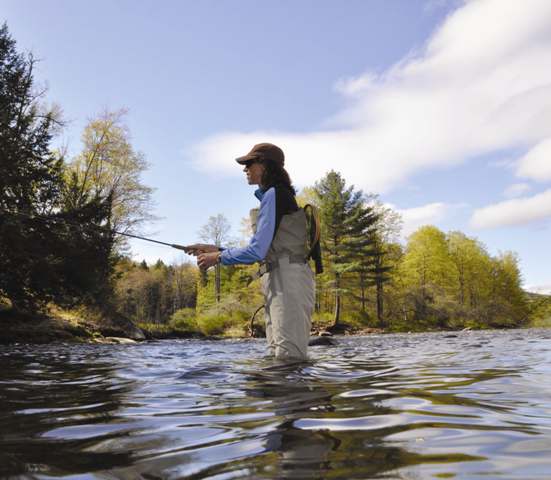Turn Your Pond or Stream to an Angler's Dream
 In the case of Igor Blake, owner of a 289-acre Tree Farm in Newport, New Hampshire, fishing on his property results in a 10 percent “recreation discount” on his taxes.“ We get a tax break because we allow anyone to fish as long as they have a New Hampshire fishing license,” explains Blake, whose forest includes 3,000 feet of frontage along the Sugar River, as well as a number of small tributary creeks. “There’s trout in the Sugar River, but we don’t actively manage for trout. The state regulates it. If you’re more open with the [public] use of the land, it helps keep it in current use.”
In the case of Igor Blake, owner of a 289-acre Tree Farm in Newport, New Hampshire, fishing on his property results in a 10 percent “recreation discount” on his taxes.“ We get a tax break because we allow anyone to fish as long as they have a New Hampshire fishing license,” explains Blake, whose forest includes 3,000 feet of frontage along the Sugar River, as well as a number of small tributary creeks. “There’s trout in the Sugar River, but we don’t actively manage for trout. The state regulates it. If you’re more open with the [public] use of the land, it helps keep it in current use.”
Allowing fishing has also helped the bottom line of the 1,100-acre Franklin Tree Farms in Jackson, Mississippi. Its owner, Julian Watson, leases a five-acre pond on his property to a hunting and fishing club, which footed the $10,000 bill to improve it.“The land has been in my family since 1870,” says Watson, “My daddy dug the pond so it means a lot to me. I wanted it to look nice, help enhance wildlife and have good water quality. The club worked with the government to refurbish it. They built a pier and stocked it with bass and bream. The bass have already grown to three pounds in only two years.”
Jim Cota and Scott Melcher, owners of Fun Forest in Sweet Home, Oregon, constructed several fire-fighting ponds around their 2,000-acre Tree Farm, then stocked them with trout, bass and bluegills. Though fishing in their ponds generates money, it’s all for charity. “We donate fishing to the Boys and Girls Club and the high school fundraisers,” says Cota. “It generates a couple thousand dollars. It’s all for the kids. It provides a lot of recreation to our families and friends, too. It’s a great way to keep kids involved. My kids were small when we started. There are no minuses.” There are many variables when it comes to creating a fish-friendly habitat: location, weather patterns, elevation, the amount of available water, its source and the size of the body of water- not to mention your budget. Here are some things to keep in mind to ensure your investment brings many years of fruitful fishing in your forest.
What fish should I stock?
It depends on the water temperature. Cold water game fish such as trout can live in water temperatures between 33 degrees F and 80 degrees depending on the subspecies, but are healthiest between 50 degrees and 65 degrees. Bass are a favorite warm water species, though many people also like to catch panfish, such as bluegills and crappie, and channel catfish. If the water in your intended fishing pond or stream warms into the 70s or higher, warm water species will generally do well there. As a general rule, it’s best to stock the type of fish already found in your area. Nonnatives might be able to flourish, but they might also escape into other bodies of water and cause problems. Your state’s department of natural resources (DNR) can assist you in determining what to stock and can often provide the fish, as well as assistance in designing your fishery and negotiating the permitting process before constructing it. If your state DNR does not provide fish for private stocking, be sure to get your fish from a licensed propagator to lower the risk of introducing invasive species, parasites and disease.
How many fish should I stock?
The larger the water volume, the better the water quality and the smaller the fish, the more fish you can put in your pond or stream. For example, in a healthy pond, if you stock between 400 to 500 four-inch trout fingerlings per acre in the fall, you’ll likely have eight-inch fish the following summer and 16-inch fish the second year. Trout grow slowly after they reach this size and have a high death rate. In addition, they rarely spawn in man-made ponds, so you may need to restock every two to three years.
If you’ve already got big fish, you’ll need to stock fewer, larger fish rather than fingerlings. “We stock 200 to 300 10-inch to 12-inch fish,” says Jim Cota of Fun Forest. “We put in larger fish because we have large fish in the ponds. If we stocked fingerlings, we would just be feeding the larger fish.” Bass tend to grow fast as long as they have adequate food sources and are not overcrowded. They also reproduce more readily in man-made ponds. The typical density for stocking bass is 100 per acre. In addition, a minimum of 500 bluegills should be added to provide forage for the bass. The formula changes with the addition of minnows, crappie, redear sunfish and channel catfish, depending on your location and the ecosystem you’ve created.It’s important to balance the fish population so that one species doesn’t take over.
It’s also a myth that adding bottom feeders, such as carp and bullhead, to your warm water pond will help keep thewater clearer. While bottom feeders slightly reduce the amount of organic matter, they dig up sediment, promoting algae growth and reducing oxygen levels in the water.
How deep should I dig?
According to the Michigan Department of Natural Resources, the minimum depth for sustaining bassand panfish in a pond is 10 feet; trout require 12 feet (unless they are in a cold-water stream or a pond that is spring fed). A trout stream should have a number of deep pockets where fish can find cooler water during the summer and that don’t freeze solid during the winter. In addition to providing a temperature gradient, if the “holes” in your stream or your pond aren’t deep enough, there won’t be enough dissolved oxygen in the water under the ice. Though your fish might survive in shallower water, they won’t grow as fast or as large and they’ll be more vulnerable to summer- and winter-kill.If you depend on groundwater as your primary water source, the depth of your fishing pond may need to be deeper than you think. A pond that is 15-feet deep might only have 12 feet of water in it if the water table is three feet below the surface.
How big should my pond be?
Though fish can happily survive and even reproduce in a quarter-acre pond under the right conditions, a pond of at least a half-acre in size increases the odds of a healthy aquatic habitat. If you plan a small pond, go deeper. For example, the Fun Forest ponds are a quarter-acre in size but 20 feet deep.
Where should I locate my pond?
Common sense dictates the two key criteria for locating a fishing pond: level ground and clean water. You might think a low-lying wetland ideal because groundwater is abundant and close to the surface. While that’s true, wetland areas are highly regulated, making permits difficult to obtain, and they can bog down excavating equipment. Upland sites are preferable. Groundwater tends to follow the contour of the land and may be close to the surface at higher elevations where the land is flat, and it’s easier to maneuver construction machinery on higher, drier locations. “We locate ponds as high as we can if we can find a spring,” says Jim Cota of Fun Forest. “We want trees around the pond, but we leave the side open where the ground breaks away as a picnic area and also as a flyway for the helicopters to dip in if there’s a fire.”
What kind of soil should be at the bottom of my pond?
Water seeps through gravel, loam and sand but pools on clay. The Natural Resources ConservationService recommends a minimum of 20 percent clay content to keep your pond from draining. If a layer of clay already exists where you plan to have the bottom of your pond, it should be substantial and even. Sandy or loamy intrusions into the clay, no matter how small, will act like a natural drain.
What if I want to block a stream to make a pond?
If you plan to make a lake or pond by impounding a stream, the dam needs to have a spillway to allow you to control the water level. A dam tends to collect sediments that need to be removed periodically. In addition, dammed water is rarely as pure as groundwater. On the other hand, groundwater may have low oxygen levels and contain excessive minerals such as iron andcopper that fish cannot tolerate. Whatever the source, it’s a good idea to test the water before committing to construction. In addition to a spillway, it helps to build a berm around your pond,stabilized with natural grasses, shrubs and a few trees. The berm filters the water and provides goodfooting for anglers. The shade from the trees keeps the water cooler for the fish. In addition, leaves and other natural debris that fall in the water provide nutrients to invertebrates that fish like to eat, as long as the debris isn’t so much that it makes the bottom murky.
What plants should I have in the water?
Emergent vegetation in the water provides food and shelter for small aquatic creatures on which your game fish feed, but there can be too much of a good thing. Excessive aquatic plant life can choke a waterway, tangle fishing lines and result in more weeds than fish on a hook. Most emergent aquatic vegetation grows in water shallower than four feet. By contouring the slope into the water, you can control the amount of vegetation that grows. Most DNRs and professional pond builders aim for a minimum 2:1 ratio, in which the bank and bottom extend two feet horizontally for every one foot of descent, to a maximum 3:1 ratio, though this is too steep for wading. Adding gravel bars or building a dock helps anglers reach the water and provides congregating areas for fish. You know you’ve succeeded at turning your pond or stream into a viable fishery not only if anglers pull lots of healthy fish from it, but also if it is clear, requires little maintenance and it looks like a natural part of your forest. Happy fishing!










A very good resource for ponds and lakes is found at www.aquahabitat.com/techfaqs.html It helps identify good clay to seal a lake and outlines the costs of ponds and lakes.
After reading this article, then reading the Aquahabitat.com site that Dave suggested, I am leaning towards the suggestions from the aquahabitat biologists. They warned against little deep ponds like the one quoted on this page since they tend to run out of oxygen in the water. I also liked their quote "cheap advice, build it twice."
Good Evening,
Wanted help to channel a stream and make a canal and pond for runaway waters during rainy season.
How could you help.
Regards
stephen
+23408153492720